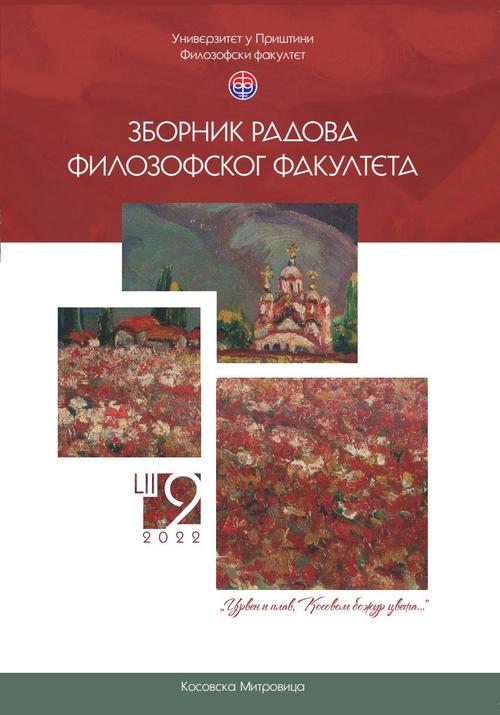Hesse’s Reader Who No Longer Reads in the Context of Modern Media
Abstract
The article analyses several of Hesse’s essays, with an emphasis on the 1920 essay On Reading Books, from the perspective of modern literary studies, psychology, and neuroscience. In the essay, Hesse made his classification of literary readers and anticipated the emergence of the “reader who no longer reads” as a kind of the enlightened reader, a human being who, thanks to his/her deep and dedicated understanding of emotions in literature, has the meaning of his/her life at his/her fingertips, who understands what he/she thinks and especially what he/she feels. Thus, it is the reader who really understands his/her emotions.
However, nowadays, in the age of digital media, a new version of the “reader who does not read” is emerging. Such a reader is an arrogant and superficial modern reader who believes he/she knows everything only because he/she can easily reach information he/she does not even really try to understand, and who hardly thinks about emotions in literature. Therefore, the second part of the article relies on two more of Hesse’s essays on reading literature, one of which anticipates the influence of multimedia on reading, and tries to explain the emergence of the modern “reader who does not read”. More specifically, the article here considers the ways how literature can foster emotions and experience in the age of digital multimedia. Namely, if we want to feel and experience while reading literature, we need to develop both the cognitive and the emotional apparatus willing and able to understand what is read, but the modern media seem to stand in the way.
It is good to point out the problem, but it is even better to offer the possibility of problem-solving; thus, the third part of the article addresses new/old knowledge about the effects of reading aloud on the development of our emotional and cognitive abilities. Of course, the methods of reading aloud in the multimedia context already exist, and they are successful, so the article also presents a study on stimulating emotions and empathy by the method of reading aloud.
References
Al Madi, N. S. & Khan, J. I. (2015). Is Learning by Reading a Book Better Than Watching a Movie? A Computational Analysis of Semantic Concept Network Growth During Text and Multimedia Comprehension. In: 2015 International Joint Conference on Neural Networks (IJCNN). Preuzeto sa: https://scihub.se/10.1109/IJCNN.2015.7280761 (28. 5. 2022).
Bartolucci, M. & Batini, F. (2020). Reading Aloud Narrative Material as a Means for the Student’s Cognitive Empowerment. Mind, Brain, and Education, 14 (3), 235–242.
Berrong, R. M. (2014). A Significant Source for the Madeleine and Other Major Episodes in Combray: Proust’s Intertextual Use of Pierre Loti’s My Brother Yves. Studies in 20th & 21st Century Literature, 38 (1), 1–17.
Bohn-Gettler, C. M. (2019). Getting a Grip: The PET Framework for Studying How Reader Emotions Influence Comprehension. Discourse Processes, 56 (5–6), 386–401.
Bohn-Gettler, C. M. & Rapp, D. N. (2014). Emotion during Reading and Writing. In: R. Pekrun & L. Linnenbrink-Garcia (Eds.), International Handbook of Emotions in Education (437–457). New York: Taylor & Francis.
Dillon, A. (1992). Reading from Paper Versus Screens: A Critical Review of the Empirical Literature. Ergonomics, 35 (10), 1297–1326.
Furenes, M. I., Kucirkova, N., Bus, A. G. (2021). A Comparison of Children’s Reading on Paper Versus Screen: A Meta-Analysis. Review of Educational Research, 91 (4), 483–517.
Ghosn, I. (2001). Nurturing Emotional Intelligence through Literature. Semantic Scholar. Preuzeto sa: https://www.semanticscholar.org/paper/Nurturing-Emotional-Intelligence-through-Ghosn/f4d14cb628b11c9f63526e4690292b-c316217e12 (8. 12. 2021).
Gillan, C. M. & Rutledge, R. B. (2021). Smartphones and the Neuroscience of Mental Health. Annual Review of Neuroscience, 44, 129–151.
Hesse, H. (1974). My Belief: Essays on Life and Art. New York: Farrar Straus & Giroux.
Hesse, H. (1979). Igra staklenih perli. Beograd: Narodna knjiga.
Hesse, H. (1984). Magija knjige. Novi Sad: Srpska čitaonica i knjižnica.
Hesse, H. (2003). Misli. Zagreb: Zagrebačka naklada.
Jabr, F. (2013). The Reading Brain in the Digital Age: The Science of Paper versus Screens. Scientific American. Preuzeto sa: https://www.scientificamerican.com/article/reading-paper-screens/ (5. 2. 2021).
Jopling, D. A. (2000). Self-Knowledge and the Self. New York: Routledge.
Lazzarich, M. i Čančar, A. (2020). Dječja lektira i novi mediji. Metodički ogledi, 27 (2), 149–170.
Peti-Stantić, A. (2019). Čitanjem do (spo)razumijevanja. Od čitalačke pismenosti do čitateljske sposobnosti. Zagreb: Naklada Ljevak.
Proust, M. (1981). Combray. Zagreb: Nakladni zavod Matice hrvatske.
Sabljak, Lj. (2021). Uloga emocija u procesu interpretacije književnoga djela vođenim čitanjem. Kroatologija: časopis za hrvatsku kulturu, 12 (2–3), 101–129.
Senawati, J., Suwastini, N. K. A., Jayantini, G. A. S. R., Adnyani, N. L. P. S., Artini, N. N. (2021). The Benefits of Reading Aloud for Children: A Review in EFL Context. Indonesian Journal of English Education (IJEE), 8 (1), 73–100.
Vladilo, I. (2002). Lektira – radost čitanja ili tortura. U: B. Šušnjić (ur.), Zbornik radova Proljetne škole školskih knjižničara (89–94). Novi Vinodolski – Rijeka: Ministarstvo prosvjete i športa Republike Hrvatske.
The details about the publication policy, including copyright and licensing, are available at:

